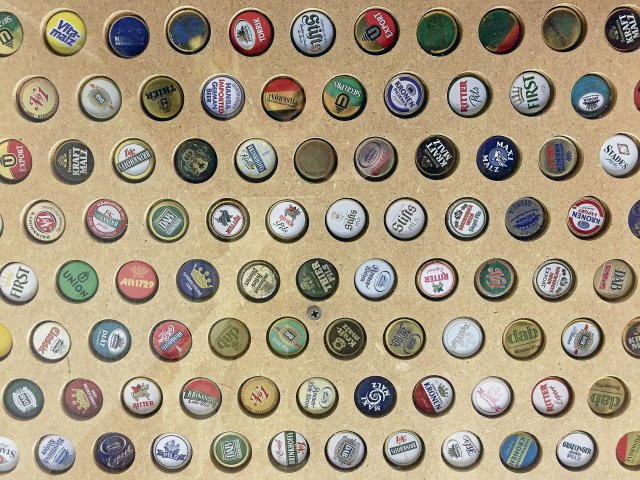They look like a bag of gummy bears but for beer lovers: bottle caps
Photo: Uta Baatz
The Borussia brewery on Dortmund’s Steigerstrasse was once the inspiration when the club’s founders chose a name for their football club. The baptism, as it says in the catalog book “Brauerei-Museum Dortmund”, resulted from a successful one-two: On the one hand, an old brewery sign in the “Wildschütz” restaurant commemorated the inaugural meeting of forty sports fans on December 20, 1909 met, the brewery, which had already gone bankrupt in 1901, and its beer, which was popular in the north of Dortmund. On the other hand, “Borussia” was a fashionable name for sports and other clubs in Prussia in those years. While beer, coal and steel formed the triad that made Dortmund the leading German industrial city in the 20th century, the BVB 09 football team also contributed to Dortmund’s international reputation. A photo from 1956 kept in the Dortmund city archive shows “Adi” Preißler, the team captain of BVB 09, with the championship trophy. Fans hold out beer mugs from the Dortmund Union Brewery to him.
The connections surrounding beer are illustrated in the brewery museum on Steigerstrasse in Dortmund. This is housed in the former machine house of the Hansa brewery and the adjacent production hall. The cultural history of Dortmund beer production is presented in twenty sections: from the raw materials hops, malt and water to the beer in the glass. Impressions are conveyed of the heyday of the beer city of Dortmund since the 1950s as well as the history of the numerous Dortmund breweries, and the process of brewing, especially industrial brewing, is explained. History is also taken into account. In contrast to coal and steel, the classic leading sectors and industrial roots of the city’s economy, the brewing industry can look back on a tradition that goes back far into the past.
As early as 1293, Dortmund breweries were granted so-called “rights of ownership”. The first surviving written reference from 1250 indicates that beer production was also the responsibility of women at that time. In Dortmund, according to city accounts from 1390 to 1398, the grut was composed of “portze”, i.e. the heather plant Porst, barley and oat malt, resin, laurel and a spice that was not originally part of the “fermentum” recipe, hops. While the brewing industry experienced an economic decline in the 17th and 18th centuries, the introduction of the bottom-fermented, “Bavarian” brewing method around the mid-1840s marked the beginning of a long-lasting upswing. The new beer gained worldwide fame as “Dortmunder Helles” or “Dortmunder Export”.
The Dortmund Actien beer was later advertised with the phrase “The world-famous beer.” Around 1900 there were almost 30 breweries, of which only eight remained in the 1920s – the Union, Actien, Ritter, Hansa, Stifts, Kronen, Thier and Bergmann breweries. Dortmund beer has been protected domestically as a designation of origin since 1904. After the Second World War, the Dortmund breweries, which were already in ruins, were forbidden from brewing beer by the British military administration’s ale drinkers. The brewhouses were only allowed to resume operations after 1949.
In the 1960s, every fifth beer drunk abroad came from the Westphalian metropolis. Since the 1970s, the simple pubs have suffered from the trend towards beer in the local “slipper cinema”. Today the traditional brands are brewed and bottled in the Dortmund Actien brewery, the last remaining brewery belonging to the Radeberger Group, on Steigerstrasse.
Filling and bottle cleaning machines from the 1950s are among the exhibits in the brewery museum, as are labeling machines, crown capping machines and barrels.
Until well into the 20th century, the beer mainly left the brewery in barrels, for example on the Krupp truck from 1922, which is a parade exhibit in the brewery museum. Another such exhibit is a counter that comes from the “Haus Wagener,” a restaurant built in Lütgendortmund in 1904 by the Westfalia Brewery, which was founded five years earlier. Dortmund beer has been flowing at the bar on display for over eighty years. During dismantling, a beer mat with a printed slogan of the German Colonial Society from the 1920s was found. Beer mats, bottle caps, plates with the breweries’ logos, glasses and mugs as well as all sorts of promotional items are also part of the museum’s inventory.
One section is dedicated to working conditions in industrial breweries. The working conditions there were particularly harsh at the beginning. Hard physical work, working hours of 60 to 75 hours a week with low wages, starting work early, and often night work were the norm. In addition, there was a patriarchal employment relationship that came from the old craft: the journeymen had to live in the brewery. Since the 1890s, working conditions have improved thanks to technical progress. Until December 31, 2023, former employees of the Dortmund Actien Brewery will provide insights into their working worlds in a special exhibition.
A “pantheon” of Dortmund breweries in the 20th and 21st centuries has been set up in a glass display case in the brewery museum. At the lowest level, represented by embossed bottles and a jug: breweries before the First World War. Breweries are also listed here that, like the Hörder Stifts Brewery, were still outside the city limits at the time. The second level applies to breweries up to the mergers of the Dortmunder Actien-Brauerei (DAB) and Hansa as well as Union and Ritter (1971/72), represented by large jugs. On level three, represented by glasses: breweries up to the takeover of the Kronen brewery, which had previously taken over the Stifts (1986) and the Thier breweries (1992). And finally on level four: The last two major breweries in Dortmund until 2005.
“A beer,” says Fritz Maytag, owner of the Anchor Brewing Company in San Francisco, “doesn’t just happen by itself. This also includes a bit of magic and certain things that no one really understands.” And which therefore cannot be exhibited in any museum.
Museyroom
The power lies in the museum. Do not you believe? Come on in! Every month we present one, in text and pictures. Just as James Joyce wrote in “Finnegans Wake”: “This is the way to the museum room.”
Subscribe to the “nd”

Being left is complicated.
We keep track!
With our digital promotional subscription you can read all issues of »nd« digitally (nd.App or nd.Epaper) for little money at home or on the go.
Subscribe now!
link sbobet link sbobet sbobet judi bola online
